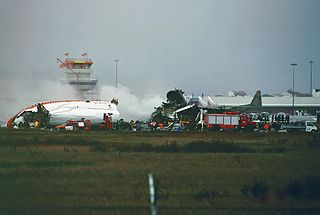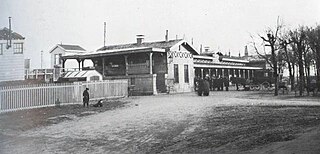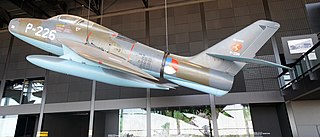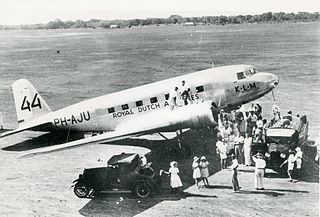
Martinair Flight 495 was a McDonnell Douglas DC-10 operated by Dutch airline Martinair, that crash-landed in severe weather conditions at Faro Airport, Portugal on 21 December 1992. The aircraft carried 13 crew members and 327 passengers, mainly holidaymakers from the Netherlands. 54 passengers and 2 crew members died. 106 of the other occupants were badly injured.

On 10 August, 1856 two passenger trains collided at the Amsterdam–Haarlem–Rotterdam railway near Delfshaven between Schiedam Centrum station and Rotterdam Centraal station, the Netherlands. Two carriages where destroyed with a third being severely damaged. Three passengers lost their lives and at least nine were injured.

Delta Air Lines Flight 705 was a regularly scheduled Delta Air Lines domestic flight from Chicago Municipal Airport, to Miami International Airport.

Gerrit Johannes "Geys" Geysendorffer was a Dutch aviation pioneer, knight in the Order of Orange-Nassau, and recipient of the 1926 Harmon National Trophy for the Netherlands.

On 20 November 1960 a F-84F Thunderstreak of the Royal Netherlands Air Force crashed at 7:50pm into a farm in Lutjelollum between Wjelsryp and Franeker, the Netherlands. The pilot and the family of six people who lived at the farm were all killed. The farm was destroyed and burned down and the livestock was killed.

On 22 September 1956, a Lockheed T-33 of the Royal Netherlands Air Force crashed at c. 01:45pm in a housing block in Eindhoven, the Netherlands. The pilot and one person on the ground were killed. Four houses burned down, twelve houses partly burned down and many more were severely damaged.

The Transports Aériens Intercontinentaux Douglas DC-6B scheduled flight from Saigon, Vietnam to Paris, France crashed on 20 February 1956 before its third stopover 25 km North-East of Cairo International Airport due to crew error and possible fatigue. 52 people on board were killed.

On 24 November 1956 the Linee Aeree Italiane Douglas DC-6B "I-LEAD" was an international scheduled passenger flight from Rome via Paris and Shannon to New York. Shortly after take off from Paris Orly Airport the airplane lost altitude and crashed into houses in the commune Paray-Vieille-Poste. 34 of the 36 people on board were killed, including Italian orchestral conductor Guido Cantelli.
Full Play was a major aviation exercise of the North Atlantic Treaty Organization (NATO) that took place over a three-day period in June 1958 in the North West NATO region.
George Alexander “Gijs” Koppen was a Dutch military officer and pilot. He is most known as and aviation pioneer flying in 1927 the first return mail flight from Amsterdam to Batavia in a record time, laying the foundation for a postal service between the Netherlands and the Dutch East Indies, the largest postal connection in the world for years.
Max Wilhelm Douwe Christern was a Dutch-born German aviator of Swedish descent. During World War II he fled by plane to avoid conscription and became a pilot at the Royal Air Force and after the war at the Royal Netherlands Air Force. On 7 October 1946 he caused the 1946 Apeldoorn aircraft crash killing himself and 22 school children.

On 14 July 1935 Fokker F.XXII PH-AJQ Kwikstaart was an international passenger flight from Amsterdam via Hamburg and Copenhagen to Malmö. The plane crashed and burned down shortly after take-off just outside Schiphol after both left side engines failed due to a defect in the fuel system, killing four crew members and two passengers. Fourteen people survived.

On 20 July 1935 a Douglas DC-2 aircraft, registration PH-AKG, operated by KLM, flying from Milano, Italy to Schiphol, Amsterdam, in the Netherlands crashed at Pian San Giacomo, Switzerland, killing all thirteen people on board, in the deadliest KLM accident at that time. It was the company's third international passenger flight accident in one week, which became known as the "black week". This left KLM short of crew and airplanes, and routes were given up; the Amsterdam—Milan route was taken over by Deutsche Lufthansa.

On 19 December 1934 the KLM Royal Dutch Airlines operated Douglas DC-2-115A Uiver was an extra scheduled international Christmas mail-and-passenger flight from Schiphol Airport in Amsterdam, the Netherlands, to Batavia in the Netherlands East Indies with eight intermediate stops.
Prof. Eduard Willem Walch often written as E.W. Walch was a Dutch professor of health science in the Dutch East Indies with expertise in hygiene and malaria control.

On 16 July 1935 a Douglas DC-2 aircraft, registration PH-AKM, operated by KLM, flying from Batavia, Dutch East Indies with several stopovers to Schiphol, Amsterdam, the Netherlands. After an emergency landing in Bushire, Iran the plane crashed the next day during take-off and the plane burned down.

On 25 June 1925, KLM-owned Fokker F.III H-NABM was a passenger flight from Schiphol Airport, the Netherlands to Paris, France. Due to bad weather it struck trees in the Forêt de Mormal and crashed. The pilot and all three passengers were killed.

The 1970 Berrechid crash was an aviation incident involving a Sud Aviation SE-210 Caravelle III on a route between Agadir and Paris, with a stopover in Casablanca.
On 5 February 1960, a Douglas DC-4 passenger aircraft of Lloyd Aéreo Boliviano on a domestic flight from Cochabamba to La Paz, Bolivia, crashed shortly after take-off. All 59 people on board were killed.


















